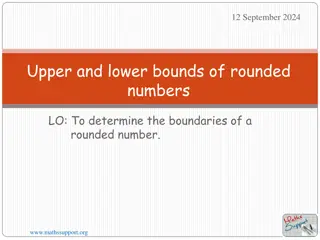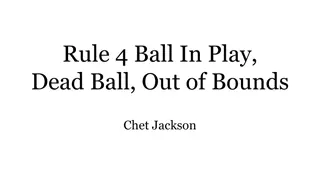Cryptographic Reductions and Learning in Computational Complexity
This lecture explores the connection between computational complexity and cryptography, focusing on topics like pseudorandom functions, public-key cryptography, and learning from Gaussians. It delves into the implications of cryptographic reductions, lower bounds for learning MLPs, and the existence
0 views • 22 slides
Strong Average-Case Circuit Lower Bounds: A Brief Overview
Exploring the history and motivation behind the Circuit Lower Bounds Program focused on proving complexity class separations through non-trivial derandomization, with a primary emphasis on Strong Average-Case Lower Bounds. Ren and Chen delve into the pursuit to establish ?? ≠ ? since the 1980s.
0 views • 61 slides
Understanding Tail Bounds and Inequalities in Probability Theory
Explore concepts like Markov's Inequality, Chebyshev's Inequality, and their proofs in the context of random variables and probability distributions. Learn how to apply these bounds to analyze the tails of distributions using variance as a key parameter. Delve into examples with geometric random var
0 views • 27 slides
Insights on Computational Complexity Threshold Results
Exploring the challenges in proving major lower bounds for computational complexity, focusing on the Hardness Magnification and Minimum Circuit Size Problem (MCSP). Discusses the difficulties in proving weak and strong LBs, highlighting recent theorems and barriers that impact progress in the field.
0 views • 21 slides
Understanding Real Analysis: Intervals, Bounds, and Problem-solving
Explore the concepts of intervals and bounds in real analysis, including open and closed intervals, semi-closed intervals, least upper bound, and greatest lower bound. Learn how to solve problems based on intervals and bounded sets through detailed explanations and examples.
0 views • 11 slides
Understanding Real Analysis: Intervals, Bounds, and Problem Solving
Explore the world of real analysis through intervals, bounds, and problem-solving techniques. Learn about open intervals, closed intervals, semi-closed intervals, infinite intervals, least upper bound, greatest lower bound, and solve problems based on intervals and bounded sets. Enhance your underst
1 views • 11 slides
Understanding Rounding and Estimating: Upper and Lower Bounds Example
Explore how to determine upper and lower bounds after rounding numbers to the nearest 1000 or 100. Learn how to calculate the error intervals and practice your skills with provided examples. Gain a clear understanding of rounding to the nearest whole number and how to identify boundaries in estimati
1 views • 4 slides
Distribution Testing Algorithms for Property and Equivalence Testing
Distributional Property Testing involves determining if a sample satisfies a given property or is from a specific distribution. The ANACONDA algorithm and other methods are used to test for uniformity, identity, and equivalence of distributions in various domains. Results show complexities and chall
2 views • 24 slides
Understanding Stability and Generalization in Machine Learning
Exploring high probability generalization bounds for uniformly stable algorithms, the relationship between dataset, loss function, and estimation error, and the implications of low sensitivity on generalization. Known bounds and new theoretical perspectives are discussed, along with approaches like
0 views • 8 slides
Generalization Bounds and Algorithms in Machine Learning
Generalization bounds play a crucial role in assessing the performance of machine learning algorithms. Uniform stability, convex optimization, and error analysis are key concepts in understanding the generalization capabilities of algorithms. Stability in optimization, gradient descent techniques, a
0 views • 16 slides
Enhancing Quality of Service in Ultra High Rate Wi-Fi Networks
This document explores the potential improvements in Quality of Service (QoS) for Ultra High Rate (UHR) Wi-Fi networks, focusing on the benefits of timing information sharing for traffic urgency assessment. It discusses areas such as increased reliability, lower latencies, improved manageability, an
0 views • 11 slides
Investigating Power and Area Reduction Bounds in 3D Integration
This study focuses on establishing upper bounds for power and area reduction in 3D Integrated Circuits (3DICs), specifically exploring the benefits of multi-tier 3DICs compared to lower-tier configurations. Previous works and evaluations on power and wirelength benefits are discussed, highlighting t
0 views • 24 slides
Exploring the Power of Wise Queries in Statistical Learning
Dive into the world of statistical learning with a focus on the impact of wise queries. Discover how statistical problems are approached, the significance of statistical queries, and the comparisons between wise and unary queries. Explore the implications for PAC learning and uncover key insights in
0 views • 8 slides
Understanding Upper and Lower Bounds in Rounding and Estimating
Learn how to calculate upper and lower bounds and error intervals when rounding numbers to significant figures. Practice rounding to different significant figures and apply the concept to various numerical values. Develop a solid grasp of estimation techniques with informative examples and visual ai
1 views • 5 slides
Insights into Advanced Algorithmic Problems
Delve into discussions surrounding complex algorithmic challenges, such as the limitations in solving the 3-SAT problem within specific time bounds, the Exponential Time Hypothesis, proving lower bounds for algorithms in various scenarios, and exploring approximation ratios in algorithm design. Thes
1 views • 65 slides
Rounding Numbers and Establishing Limits in Mathematical Accuracy
Performing rounding calculations to the nearest 10 and 1 decimal place, understanding limits of accuracy in measurements, analyzing potential accuracy problems in precision engineering, and exploring the concept of upper and lower bounds within mathematical contexts.
0 views • 13 slides
Exploring Complexity in Computational Theory
Dive into a world of computational complexity and theory with a focus on topics such as NP, P, PH, PSPACE, NL, L, random vs. deterministic algorithms, and the interplay of time and space complexity. Discover insights on lower bounds, randomness, expanders, noise removal, and the intriguing question
0 views • 17 slides
Understanding Tail Bounds in Probability for Computing
Tail bounds in probability theory play a crucial role in analyzing random variables and understanding the behavior of certain events. This content explores the concept of tail bounds, their importance through examples, and the derivation of upper bounds on tails. Markov's inequality is also discusse
0 views • 31 slides
Quantum Query Complexity Measures for Symmetric Functions
Explore the relationships between query complexity measures, including quantum query complexity, adversary bounds, and spectral sensitivity, in the context of symmetric functions. Analysis includes sensitivity graphs, the quantum query model, and approximate counting methods. Results cover spectral
0 views • 19 slides
Numerical Abstract Domain with Max Operator in Timing Analysis
Explore a numerical abstract domain based on expression abstraction and the Max operator with applications in timing analysis. The challenges in timing analysis, such as disjunctive and non-linear bounds, are discussed along with simple examples illustrating these concepts. The difficulty of proving
0 views • 21 slides
Lower Allen Township Public Safety Ad Hoc Committee Fire/Rescue Services Presentation
The Lower Allen Township Public Safety Ad Hoc Committee organized a Fire/Rescue Services Presentation featuring presenters from Lower Allen Fire Company, Lisburn Community Fire Company, and Lower Allen Dept. of Public Safety. The presentation focused on identifying capability gaps, preparing for dif
0 views • 45 slides
Leakage-Resilient Key Exchange and Seed Extractors in Cryptography
This content discusses the concepts of leakage-resilient key exchange and seed extractors in cryptography, focusing on scenarios involving Alice, Bob, and Eve. It covers non-interactive key exchanges, passive adversaries, perfect randomness challenges, and leakage-resilient settings in symmetric-key
6 views • 35 slides
Understanding Decision Trees in Problem Solving
A decision tree is a crucial tool in problem-solving, providing a systematic way to analyze and make decisions based on inputs. This content explores decision tree concepts, their application in sorting and binary search problems, and practical examples like the nuts-and-bolts matching dilemma. It d
2 views • 20 slides
Analysis on Oil's Impact on Civil War and State Weakness
The analysis delves into the potential causal effects of oil on civil war and state weakness. By examining the observed data and establishing bounds, it suggests that oil could either significantly reduce wars or have a small positive effect. Furthermore, it explores how oil may lead to war through
1 views • 6 slides
Additive Combinatorics Approach to Log-Rank Conjecture in Communication Complexity
This research explores an additive combinatorics approach to the log-rank conjecture in communication complexity, addressing the maximum total bits sent on worst-case inputs and known bounds. It discusses the Polynomial Freiman-Ruzsa Conjecture and Approximate Duality, highlighting technical contrib
0 views • 9 slides
Understanding Upper and Lower Bounds in Measurements
Explore the concept of upper and lower bounds in measurements through examples involving rounding numbers and calculating boundaries for different units like centimeters, millimeters, and meters. Learn how to determine the range within which a rounded number falls for both discrete and continuous da
0 views • 9 slides
Understanding Upper and Lower Bounds in Mathematics
Exploring the concept of upper and lower bounds in mathematics, this content discusses how numbers are rounded to the nearest whole number and identifies the possible maximum and minimum values. It also provides examples and rules for finding upper and lower bounds, as well as practical applications
0 views • 6 slides
Understanding Significant Figures in Mathematics and Science
Significant figures play a crucial role in maintaining accuracy and precision in mathematical and scientific calculations. They help in determining the level of accuracy of measurements and calculations by focusing on the number of significant digits and decimal places. Rounding rules are essential
0 views • 6 slides
Exploring Circuit Size Bounds in Complexity Theory
The article delves into Shannon's Theorem in Complexity Theory, discussing the upper bounds of circuit sizes for Boolean functions of n variables. It explores the 1-1 correspondence with 0-1 strings of length 2n and how Boolean functions can be expressed as CNF or DNF formulas. The computation of th
2 views • 19 slides
Advanced Techniques for Heavy Hitters Detection in Insertion Streams
Beating CountSketch algorithms, like those presented by David P. Woodruff and team, offer innovative solutions for identifying heavy hitters in insertion streams with minimal space complexity. Guarantees such as L1 and L2 outputs and the CountSketch approach are explored to achieve efficient heavy h
0 views • 18 slides
Understanding Lower Bounds in the Cell Probe Model
Exploring the concept of lower bounds for static data structures, this content delves into the tradeoffs between query time and space efficiency. It discusses the need for proving lower bounds, the model of data structures, and how CPUs access memory in computational devices. Kasper Green Larsen fro
0 views • 45 slides
Understanding Rule 4: Ball In Play, Dead Ball, Out of Bounds
Exploring Rule 4 of the game rules, this article delves into Ball In Play, Dead Ball, and Out of Bounds situations, discussing key scenarios like legal snaps, live ball becoming dead, and the impact of inadvertent whistles. It covers rules regarding ball positioning, player actions, and referee sign
0 views • 14 slides
Understanding Big-Oh Notation in Time Complexity Analysis
Big-Oh notation in algorithm analysis signifies how the runtime of an algorithm grows in relation to the input size. It abstractly characterizes the worst-case time complexity, disregarding constants and lower-order terms. The concept of Big-Oh, along with Big-Omega and Big-Theta, helps in comparing
0 views • 18 slides
Communication Lower Bounds of Key-Agreement Protocols
Key-agreement protocols play a vital role in secure communication between parties. This document explores lower bounds of key-agreement protocols through density increment arguments, idealization of symmetric primitives, Merkle puzzles, and the impact of communication bits between Alice and Bob. Var
0 views • 10 slides
Lower Bounds for Small Depth Arithmetic Circuits
This work explores lower bounds for small-depth arithmetic circuits, jointly conducted by researchers from MSRI, IITB, and experts in the field. They investigate the complexity of multivariate polynomials in arithmetic circuits, discussing circuit depth, size, and the quest for an explicit family of
0 views • 114 slides
Lower Bounds on Sampling Good Codes in Bounded-Depth Circuits
Bounded-depth circuits are proven unable to sample or approximate good codes effectively. This work delves into lower bounds, showcasing that bounded families of circuits face limitations in computing specific functions or sampling distributions. The example of Parity in AC0 circuits illustrates the
0 views • 21 slides
Advanced Techniques for Orthogonal Skyline Counting Queries
Advanced techniques for orthogonal skyline counting queries discuss optimal planar solutions, dividing and conquering for topmost point identification, efficient vertical slab counting, succinct data structures for prefix sums and range maxima, upper bounds on degree and multi-slab queries, as well
0 views • 11 slides
Understanding Measurement Bounds and Accuracy
Exploring the concepts of significant figures, bounds, accuracy, and ranges in measurement. From determining the smallest and largest possible lengths to finding lower and upper bounds based on accuracy, this content focuses on practical exercises and explanations to enhance understanding. Learn how
0 views • 6 slides
Understanding Propositional Proof Complexity and Lower Bounds
Studies focus on the intractability of propositional proof complexity, exploring the power of proof systems to verify tautologies. Discussion on known lower bounds and challenges in proving hardness of certain tautologies.
0 views • 23 slides
Beating the Harmonic Lower Bound for Online Bin Packing - Strategies and Results
Explore the strategies and results in online bin packing as presented by Sandy Heydrich and Rob van Stee. The discussion delves into competitive ratios, known upper and lower bounds, the HARMONIC algorithm, and improvements such as the SUPERHARMONIC concept. Discover the challenges and optimizations
0 views • 24 slides







































